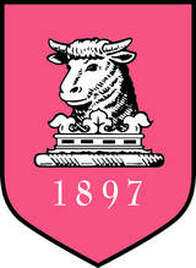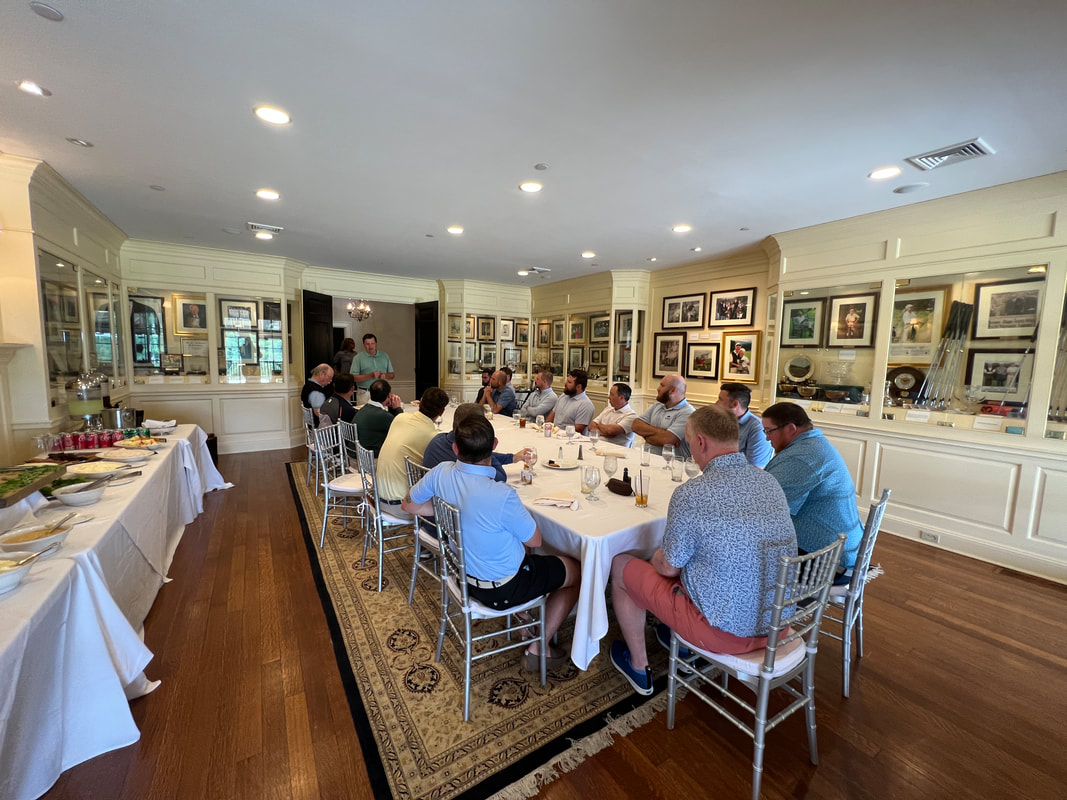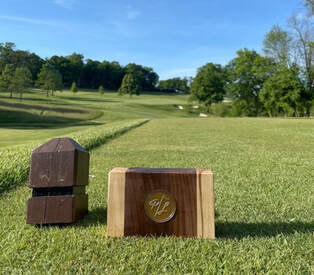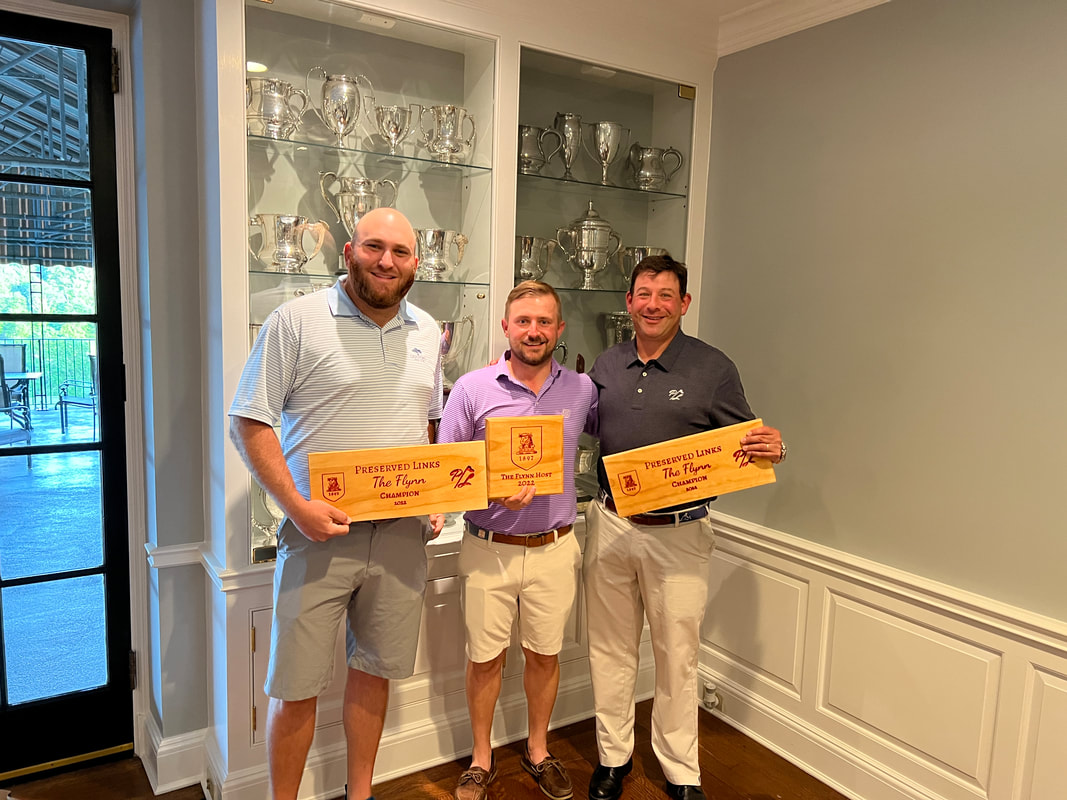|
Huntingdon Valley Country Club
Architect: William Flynn Year: 1990 2295 Country Club Dr, Huntingdon Valley, PA 19006 Phone: 215-657-1610 Course Access: Private www.hvccpa.org |
Huntingdon Valley Country Club
The Early Years in NobleAlthough there were a few courses in the USA before 1800, none survived. It was not until well after the Civil War that golf really took off in the United States. According to the USGA the oldest club still operating is the Club at St. Andrews, Ardsley, NY (1888). From then until the turn of the century over a thousand clubs were formed. Huntingdon Valley was the first club in the Philadelphia area to be organized exclusively for golf, and even though several other local clubs had begun playing the game the year before, they had all been established as tennis and/or cricket clubs. All started as 9 hole layouts. Huntingdon Valley Country Club was organized in 1896 at the suggestion of George H. Frazier to his father William W. Frazier. He and a group of friends had previously been playing the game of golf on a rough layout across several of their estates. The club was incorporated and first played in 1897.
The original Huntingdon Valley Golf Course was situated on either side of Susquehanna Road just north of Jenkintown, PA.
Early Golf Competition
From the beginning, HVCC dominated inter-club play and won the "Record Cup" so many times at the start of the century that the other clubs in the newly formed Golf Association of Philadelphia (GAP) decided to discontinue this competition. The inter-club play was resumed a number of years later, in the form of the GAP Men's Suburban League Matches, and Huntingdon Valley has continued to be a dominant force in that competition year in and year out.
HVCC Expands to 18 Holes
The Club prospered as a 9 hole course and in 1898 it was decided that a full 18 hole layout should be constructed. The Club expanded to the west and used the old Noble Estate's farm house next to Old York Road for its clubhouse. The Club's location near the Noble train station enhanced its accessibility for Members, staff and caddies, because in those days automobiles were a rarity.
The land for the additional 9 holes was initially rented and then purchased by the Club in 1911. At the same time, the original Noble Estate farm house was greatly expanded to provide the amenities associated with a first class country club. Trap shooting, squash as well as clay and grass tennis courts were added sometime later. It is reported that the golf course was rebuilt four or five times before the Golf Committee was completely satisfied, and the final layout was said to be a real challenge for even the best players. Robert Trent Jones is quoted as saying that the 8th hole was one of the finest par 3's that he had ever played.
The enlarged HVCC site was bounded by the Reading Railroad's (now SEPTA) West Trenton rail line, Old York Road and Woodland Road, and the four lane road, now called the Fairway, runs right through the middle of what was the golf course. Today, the former HVCC property is the site of the Baederwood Shopping Center, multiple car dealerships, several office buildings and the Rydal Park residential complex.
In the mid-1920's, the leaders of the Club decided to move to a new location, due to the interference from the increased automobile traffic on Susquehanna and Valley Roads. Six holes of the golf course crossed these two roads. There is no record of any fatalities resulting from the mixing of automobiles and golf balls, although a few balls went through the open sides of these early automobiles, missing both drivers and passengers.
The Club Moves North
The site selected for the new HVCC was part of a huge tract of land owned by the estate of W.W. Frazier. He was the Club's first President, a Civil War veteran and a respected business man who died in 1933 at the age of 83. Most of the land purchased by the Club was a working dairy farm in what was then Moreland Township (now Upper Moreland); however, a portion of the property is in Abington Township. The site, which was bounded by Edge Hill, Terwood, Paper Mill and Welsh Roads, was assembled primarily from the estate of W.W. Frazier. However, some additional land had to be purchased from Edward E. Marshall Sr., when it was discovered that a portion of the new golf course had been constructed beyond the boundary of the Club's property.
The original Master Plan called for the golf course and clubhouse facilities to occupy about 300 acres, and the remainder of the property was to be sub-divided into 2 to 5 acre home sites for Members. Although it was decided to build 27 holes initially, there was an understanding that more real estate could be purchased if 9 more holes were needed to expand to two 18 hole courses.
The classical style stone clubhouse, with its three dining rooms, multiple terraces overlooking the valley, and handsome guest accommodations on the upper floor, was constructed at the same time as the golf course, and it opened to rave reviews from the Members on Easter Sunday 1928. Other facilities on the new site included six clay tennis courts, which are still in use today, two squash courts and a trap shooting area.
The lower level included a Members' Room with an adjacent locker room. However, this locker room was not for golf shoes, extra clubs and balls. It was where each Member maintained his personal stock of beverages, which were served to him and his guests in richly paneled space.
The Philadelphia firm of Toomey and Flynn was retained to design and build the 27 hole layout, which was labeled a "Super Course" by the newspapers at the time it was opened for play in April 1928. William Flynn is credited with designing numerous fine golf courses in the Philadelphia area as well as nationally known courses such as Shinnecock Hills on Long Island, the Upper Cascades Course at the Homestead in Hot Springs, Virginia and Cherry Hills outside Denver.
HVCC in the Depression Era
Unfortunately, the elation about the Club's new home was short lived, because the stock market crashed in 1929, and the great depression that followed made retention of members and generation of revenue very difficult. The depression also spelled the end of the original land development plan, because shortly after George Frazier's death in 1934, the First Pennsylvania Company foreclosed on the Club's mortgage and sold off most of the land that had been intended for residential development.
The property on which the clubhouse and the golf course are situated was also thrown into receivership as a result of the difficult economic conditions; however, a group of Club Members put together a private stock plan to recover the property from the bank. Over the next forty years, a variety of financial plans held the Club together and finally in 1971, under the leadership of Edward Taws and William Goldthorp, the old bonds and stock certificates were retired and HVCC returned to its former status as a Member owned Club.
Another casualty of the depression era was the third nine, now known as the Centennial or "C" Nine. As the economic problems increased and membership was reduced, the Club had no choice but to stop maintaining these 9 holes as a part of the golf course. It was rough-cut periodically to keep it clear of trees and underbrush, but even that had to be abandoned with the imposition of gasoline rationing during World War II. When the Club decided to restore the third nine in 1996, it was a matter of starting over and cutting the golf holes out of a 50 year old forest of oak, cherry and tulip poplar trees. There were also problems with state and federal regulatory agencies that had come into being over the 70 years since the course was originally constructed. The layout of several holes on the C-nine had to be modified from the original design to avoid environmentally sensitive areas and vegetation that was classified as endangered.
With the restoration of the third nine, which reopened in 1998, Huntingdon Valley's golf course has been returned to the layout that existed when the present Club was built in 1927. In addition, there has been a carefully planned and coordinated effort over a number of years to return the other 18 holes to the design developed by William Flynn.
Huntingdon Valley Today
While the economic and social conditions we find today are unlike those that existed when Huntingdon Valley Country Club was founded more than 100 years ago, many traditions from its earliest days can still be found at the Club. Huntingdon Valley remains a family oriented Club, and the level of participation in its sports junior programs and the number of fine young golfers, tennis players and swimmers it produces bears witness to the impact of this principle.
Members of Huntingdon Valley enjoy golf, tennis, squash, paddle tennis, swimming and tap shooting, along with other pastimes such as bridge, and dining, and a newly established fitness center.
Huntingdon Valley has a wonderful mix of young, middle age and older Members and there is a true sense of common purpose throughout the membership and the Club's professional staff.
Huntingdon Valley remains in the forefront of inter-club competition in a variety of sports, and its Men's Suburban League Golf Teams have continued the winning tradition established by the founders of the Club in the late 1800's. HVCC's Women's Golf Team has won the prized Philadelphia Cup on numerous occasions, and Huntingdon Valley's Swim Team is a perennial powerhouse in the Country Club swimming league.
With over 100 years of history and tradition to call upon, the officers, board members, membership and professional staff at Huntingdon Valley Country Club look to the future with a sense of optimism and excitement.
The original Huntingdon Valley Golf Course was situated on either side of Susquehanna Road just north of Jenkintown, PA.
Early Golf Competition
From the beginning, HVCC dominated inter-club play and won the "Record Cup" so many times at the start of the century that the other clubs in the newly formed Golf Association of Philadelphia (GAP) decided to discontinue this competition. The inter-club play was resumed a number of years later, in the form of the GAP Men's Suburban League Matches, and Huntingdon Valley has continued to be a dominant force in that competition year in and year out.
HVCC Expands to 18 Holes
The Club prospered as a 9 hole course and in 1898 it was decided that a full 18 hole layout should be constructed. The Club expanded to the west and used the old Noble Estate's farm house next to Old York Road for its clubhouse. The Club's location near the Noble train station enhanced its accessibility for Members, staff and caddies, because in those days automobiles were a rarity.
The land for the additional 9 holes was initially rented and then purchased by the Club in 1911. At the same time, the original Noble Estate farm house was greatly expanded to provide the amenities associated with a first class country club. Trap shooting, squash as well as clay and grass tennis courts were added sometime later. It is reported that the golf course was rebuilt four or five times before the Golf Committee was completely satisfied, and the final layout was said to be a real challenge for even the best players. Robert Trent Jones is quoted as saying that the 8th hole was one of the finest par 3's that he had ever played.
The enlarged HVCC site was bounded by the Reading Railroad's (now SEPTA) West Trenton rail line, Old York Road and Woodland Road, and the four lane road, now called the Fairway, runs right through the middle of what was the golf course. Today, the former HVCC property is the site of the Baederwood Shopping Center, multiple car dealerships, several office buildings and the Rydal Park residential complex.
In the mid-1920's, the leaders of the Club decided to move to a new location, due to the interference from the increased automobile traffic on Susquehanna and Valley Roads. Six holes of the golf course crossed these two roads. There is no record of any fatalities resulting from the mixing of automobiles and golf balls, although a few balls went through the open sides of these early automobiles, missing both drivers and passengers.
The Club Moves North
The site selected for the new HVCC was part of a huge tract of land owned by the estate of W.W. Frazier. He was the Club's first President, a Civil War veteran and a respected business man who died in 1933 at the age of 83. Most of the land purchased by the Club was a working dairy farm in what was then Moreland Township (now Upper Moreland); however, a portion of the property is in Abington Township. The site, which was bounded by Edge Hill, Terwood, Paper Mill and Welsh Roads, was assembled primarily from the estate of W.W. Frazier. However, some additional land had to be purchased from Edward E. Marshall Sr., when it was discovered that a portion of the new golf course had been constructed beyond the boundary of the Club's property.
The original Master Plan called for the golf course and clubhouse facilities to occupy about 300 acres, and the remainder of the property was to be sub-divided into 2 to 5 acre home sites for Members. Although it was decided to build 27 holes initially, there was an understanding that more real estate could be purchased if 9 more holes were needed to expand to two 18 hole courses.
The classical style stone clubhouse, with its three dining rooms, multiple terraces overlooking the valley, and handsome guest accommodations on the upper floor, was constructed at the same time as the golf course, and it opened to rave reviews from the Members on Easter Sunday 1928. Other facilities on the new site included six clay tennis courts, which are still in use today, two squash courts and a trap shooting area.
The lower level included a Members' Room with an adjacent locker room. However, this locker room was not for golf shoes, extra clubs and balls. It was where each Member maintained his personal stock of beverages, which were served to him and his guests in richly paneled space.
The Philadelphia firm of Toomey and Flynn was retained to design and build the 27 hole layout, which was labeled a "Super Course" by the newspapers at the time it was opened for play in April 1928. William Flynn is credited with designing numerous fine golf courses in the Philadelphia area as well as nationally known courses such as Shinnecock Hills on Long Island, the Upper Cascades Course at the Homestead in Hot Springs, Virginia and Cherry Hills outside Denver.
HVCC in the Depression Era
Unfortunately, the elation about the Club's new home was short lived, because the stock market crashed in 1929, and the great depression that followed made retention of members and generation of revenue very difficult. The depression also spelled the end of the original land development plan, because shortly after George Frazier's death in 1934, the First Pennsylvania Company foreclosed on the Club's mortgage and sold off most of the land that had been intended for residential development.
The property on which the clubhouse and the golf course are situated was also thrown into receivership as a result of the difficult economic conditions; however, a group of Club Members put together a private stock plan to recover the property from the bank. Over the next forty years, a variety of financial plans held the Club together and finally in 1971, under the leadership of Edward Taws and William Goldthorp, the old bonds and stock certificates were retired and HVCC returned to its former status as a Member owned Club.
Another casualty of the depression era was the third nine, now known as the Centennial or "C" Nine. As the economic problems increased and membership was reduced, the Club had no choice but to stop maintaining these 9 holes as a part of the golf course. It was rough-cut periodically to keep it clear of trees and underbrush, but even that had to be abandoned with the imposition of gasoline rationing during World War II. When the Club decided to restore the third nine in 1996, it was a matter of starting over and cutting the golf holes out of a 50 year old forest of oak, cherry and tulip poplar trees. There were also problems with state and federal regulatory agencies that had come into being over the 70 years since the course was originally constructed. The layout of several holes on the C-nine had to be modified from the original design to avoid environmentally sensitive areas and vegetation that was classified as endangered.
With the restoration of the third nine, which reopened in 1998, Huntingdon Valley's golf course has been returned to the layout that existed when the present Club was built in 1927. In addition, there has been a carefully planned and coordinated effort over a number of years to return the other 18 holes to the design developed by William Flynn.
Huntingdon Valley Today
While the economic and social conditions we find today are unlike those that existed when Huntingdon Valley Country Club was founded more than 100 years ago, many traditions from its earliest days can still be found at the Club. Huntingdon Valley remains a family oriented Club, and the level of participation in its sports junior programs and the number of fine young golfers, tennis players and swimmers it produces bears witness to the impact of this principle.
Members of Huntingdon Valley enjoy golf, tennis, squash, paddle tennis, swimming and tap shooting, along with other pastimes such as bridge, and dining, and a newly established fitness center.
Huntingdon Valley has a wonderful mix of young, middle age and older Members and there is a true sense of common purpose throughout the membership and the Club's professional staff.
Huntingdon Valley remains in the forefront of inter-club competition in a variety of sports, and its Men's Suburban League Golf Teams have continued the winning tradition established by the founders of the Club in the late 1800's. HVCC's Women's Golf Team has won the prized Philadelphia Cup on numerous occasions, and Huntingdon Valley's Swim Team is a perennial powerhouse in the Country Club swimming league.
With over 100 years of history and tradition to call upon, the officers, board members, membership and professional staff at Huntingdon Valley Country Club look to the future with a sense of optimism and excitement.
Course Photos
Preserved Links Member Photos
Wayne provided us the original routing and plans of the course as Flynn laid it out so we set tees to recreate the original Flynn routing. Many walked away surprised how long some of the par 3s were, how short the par 5s were, and how varied the par 4s were.
Preserved Links Event "The Flynn"
Congrats to our Champions Zack Baratz, Russell Dekker, and our host champion Eric Kubilus!
Course Design Notes
Sketches Provided By: Wayne Morrison, Flynn Historian





